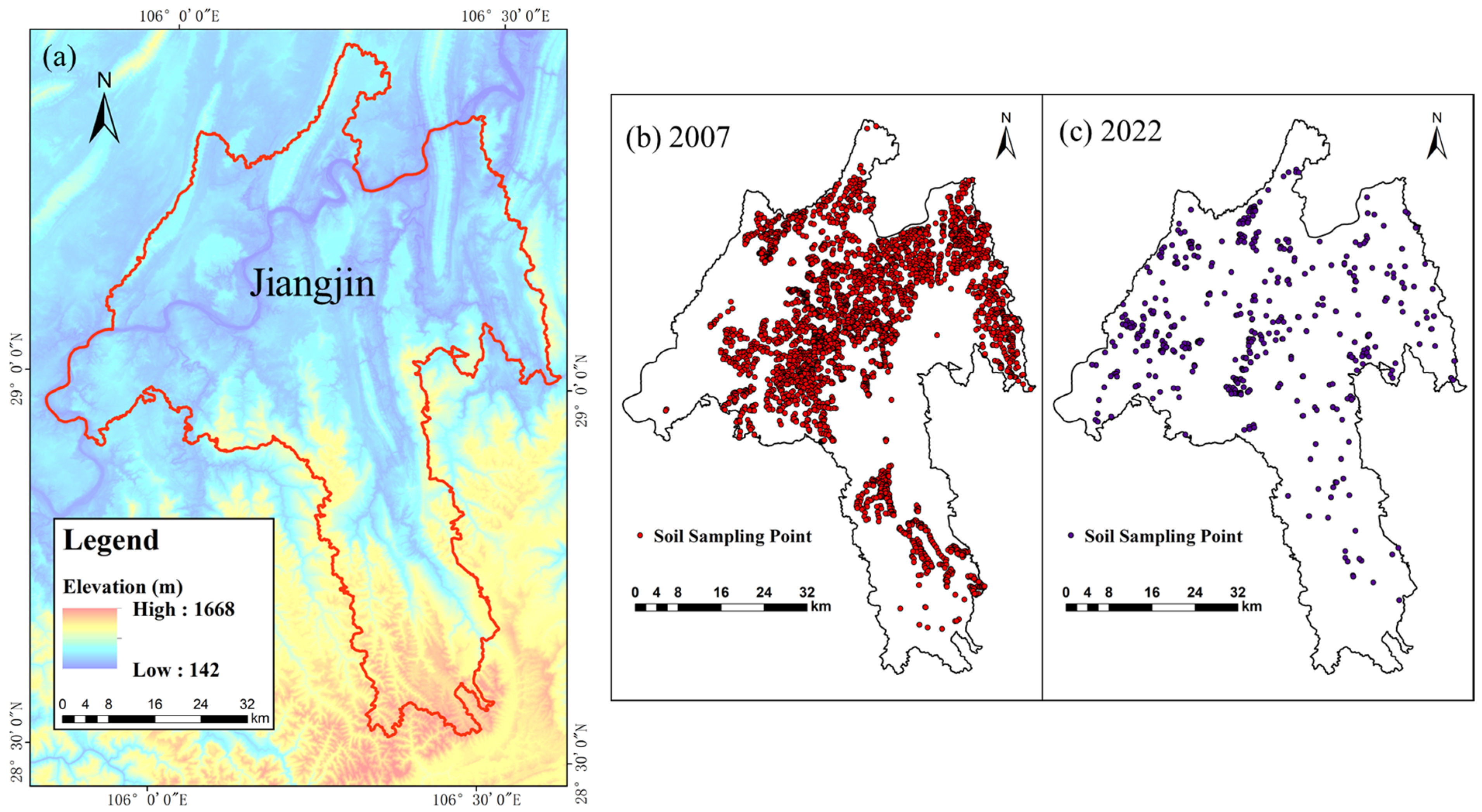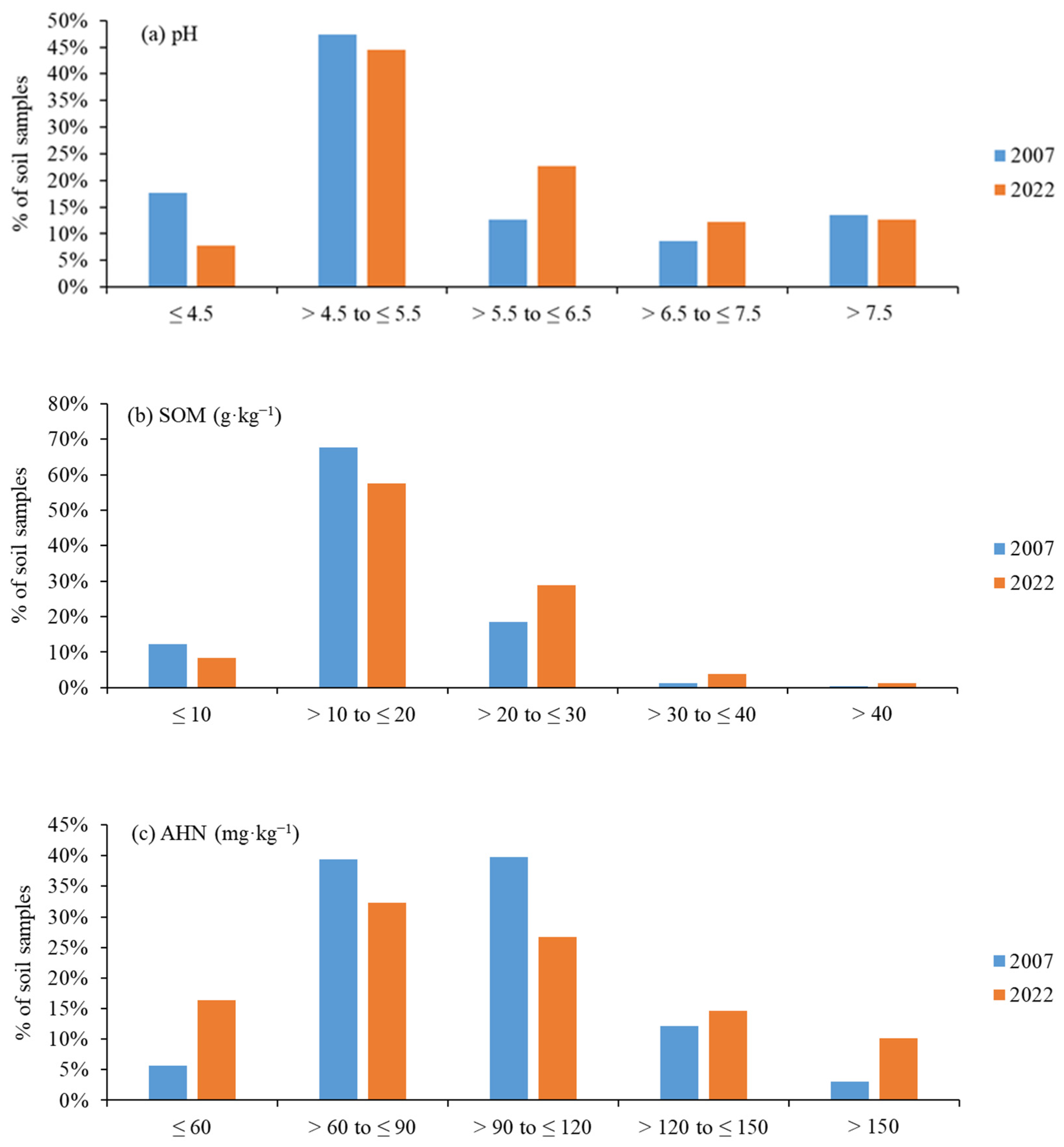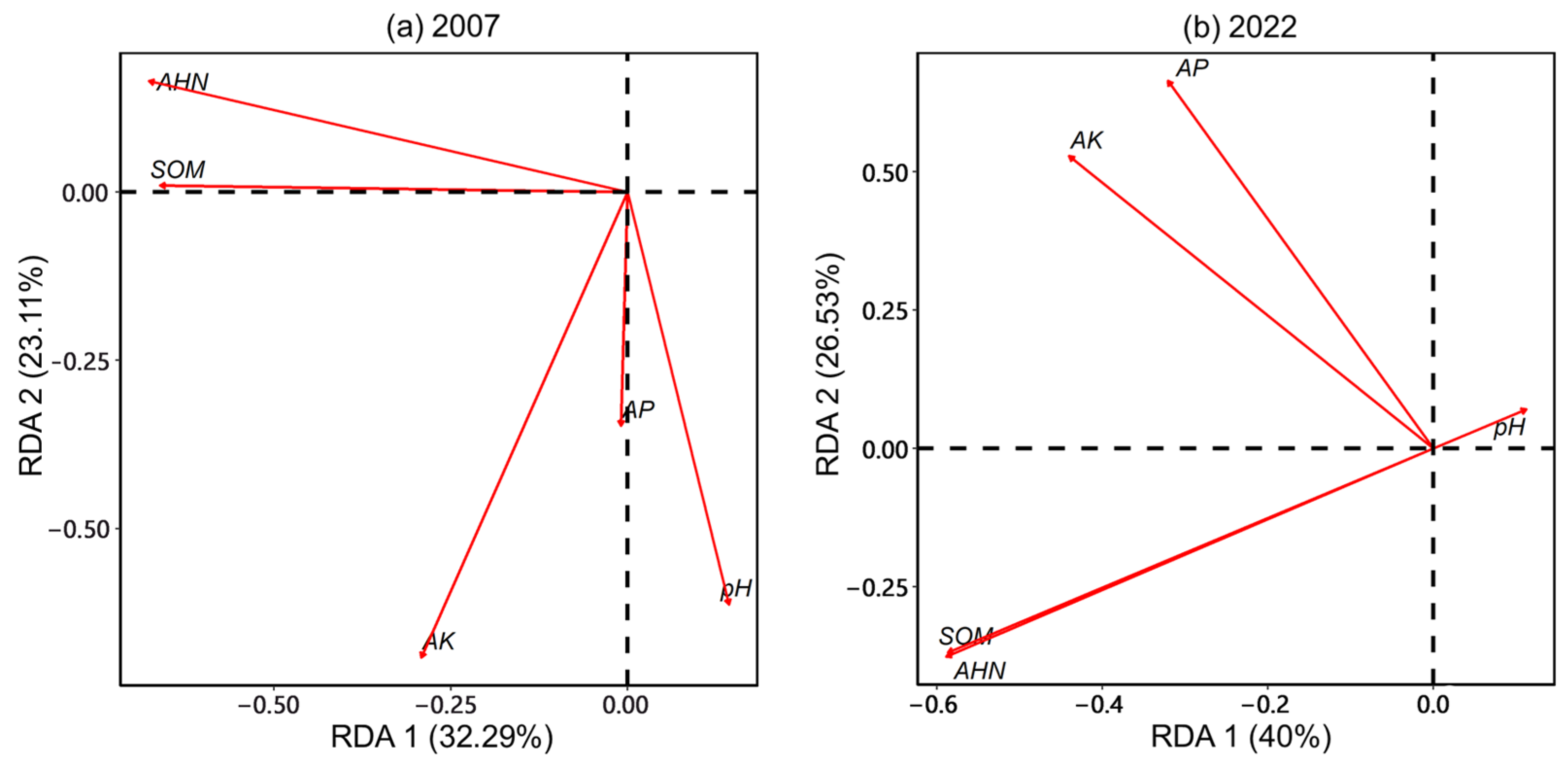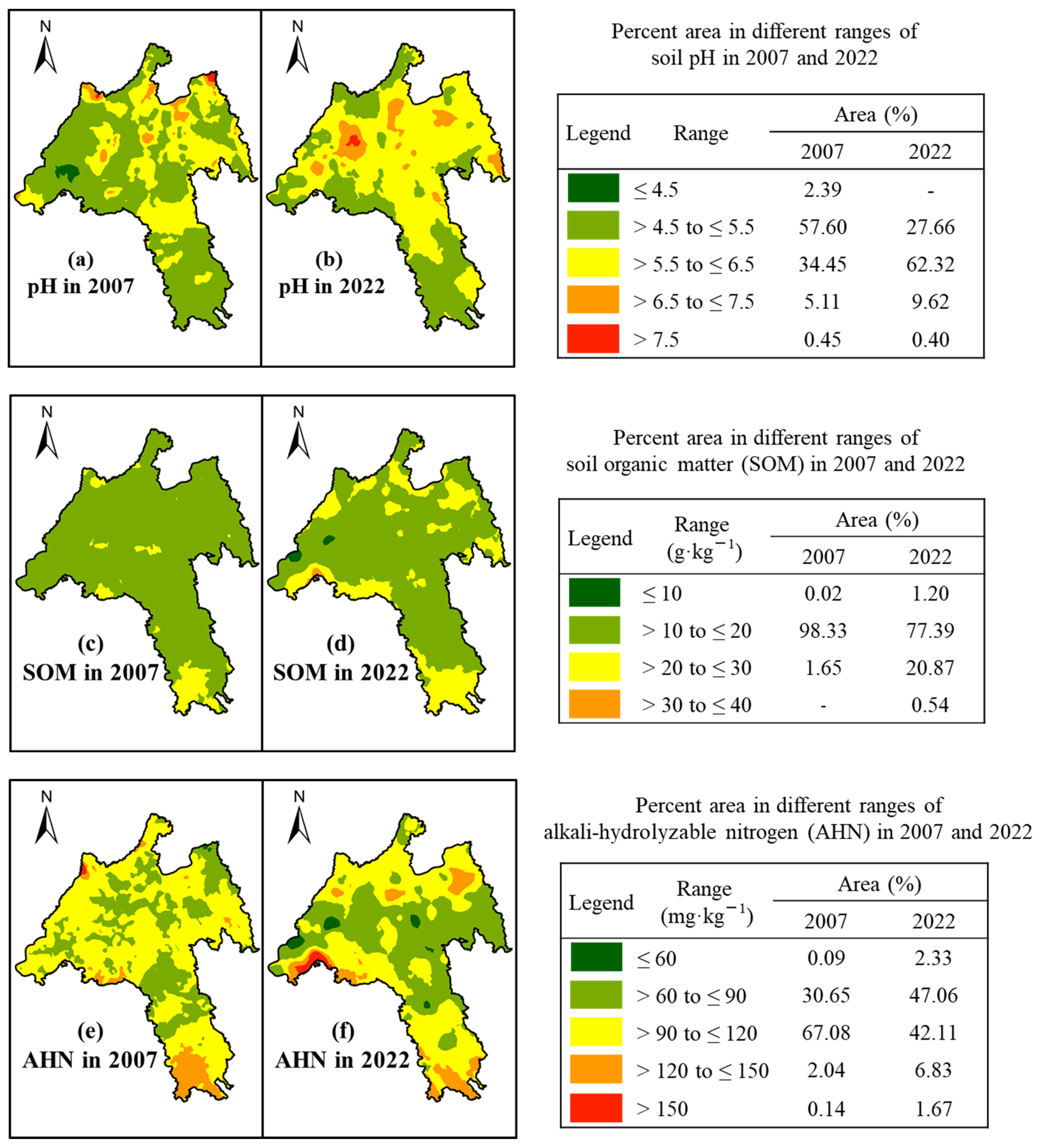Spatial and Temporal Variability of Soil pH, Organic Matter and Available Nutrients (N, P and K) in Southwestern China
Abstract
1. Introduction
2. Materials and Methods
2.1. Study Area
2.2. Data Collection
2.3. Statistical Analyses
2.4. Geostatistical Analysis
3. Results
3.1. Descriptive Statistical Analysis
3.2. Relationships between Soil Parameters
3.3. Temporal and Spatial Variability of Soil Parameters
4. Discussion
4.1. Temporal Change in Soil Parameters
4.2. Relationships between Soil Properties and Nutrients
4.3. Characteristics of Spatio-Temporal Variations of Soil Parameters
4.4. Implications and Limitations
5. Conclusions
Author Contributions
Funding
Data Availability Statement
Conflicts of Interest
References
- National Bureau of Statistics of China. China Statistical Yearbook 2023. Available online: https://www.stats.gov.cn/sj/ndsj/2023/indexch.htm (accessed on 5 August 2024).
- Yan, D.; Wu, S.; Tang, Y.; Zhu, J.; Zhou, S.; Xu, Z. Arable land and water footprints for food consumption in China: From the perspective of urban and rural dietary change. Sci. Total Environ. 2022, 838, 155749. [Google Scholar] [CrossRef] [PubMed]
- Li, Q.; Luo, Y.; Wang, C.; Li, B.; Zhang, X.; Yuan, D.; Gao, X.; Zhang, H. Spatiotemporal variations and factors affecting soil nitrogen in the purple hilly area of Southwest China during the 1980s and the 2010s. Sci. Total Environ. 2016, 547, 173–181. [Google Scholar] [CrossRef] [PubMed]
- Brown, K.A. Chemical effects of pH-3 sulfuric-acid on a soil-profile. Water Air Soil Pollut. 1987, 32, 201–218. [Google Scholar] [CrossRef]
- Honorato Fernandes, M.M.; Coelho, A.P.; Fernandes, C.; da Silva, M.F.; Dela Marta, C.C. Estimation of soil organic matter content by modeling with artificial neural networks. Geoderma 2019, 350, 46–51. [Google Scholar] [CrossRef]
- Ogle, S.M.; Breidt, F.J.; Paustian, K. Agricultural management impacts on soil organic carbon storage under moist and dry climatic conditions of temperate and tropical regions. Biogeochemistry 2005, 72, 87–121. [Google Scholar] [CrossRef]
- Rumpel, C.; Chabbi, A. Managing Soil Organic Carbon for Mitigating Climate Change and Increasing Food Security. Agronomy 2021, 11, 1553. [Google Scholar] [CrossRef]
- Wen, X.; Gu, L.; Wen, S. Job satisfaction and job engagement: Empirical evidence from food safety regulators in Guangdong, China. J. Clean. Prod. 2019, 208, 999–1008. [Google Scholar] [CrossRef]
- Zhang, X.; Zhu, A.; Xin, X.; Yang, W.; Zhang, J.; Ding, S. Tillage and residue management for long-term wheat-maize cropping in the North China Plain: I. Crop yield and integrated soil fertility index. Field Crops Res. 2018, 221, 157–165. [Google Scholar] [CrossRef]
- Mugo, J.N.; Karanja, N.N.; Gachene, C.K.; Dittert, K.; Nyawade, S.O.; Schulte-Geldermann, E. Assessment of soil fertility and potato crop nutrient status in central and eastern highlands of Kenya. Sci. Rep. 2020, 10, 7779. [Google Scholar] [CrossRef]
- Liang, Z.; Zou, T.; Gong, J.; Zhou, M.; Shen, W.; Zhang, J.; Fan, D.; Lu, Y. Evaluation of Soil Nutrient Status Based on LightGBM Model: An Example of Tobacco Planting Soil in Debao County, Guangxi. Appl. Sci. 2022, 12, 12354. [Google Scholar] [CrossRef]
- Giroux, M. Effects of nitrogen-fertilization on yields and total nitrogen-content of alfalfa (Medicago sativa L.). Nat. Can. 1979, 106, 535–538. [Google Scholar]
- Ronga, D.; Pentangelo, A.; Parisi, M. Optimizing N Fertilization to Improve Yield, Technological and Nutritional Quality of Tomato Grown in High Fertility Soil Conditions. Plants 2020, 9, 575. [Google Scholar] [CrossRef] [PubMed]
- Conley, D.J.; Paerl, H.W.; Howarth, R.W.; Boesch, D.F.; Seitzinger, S.P.; Havens, K.E.; Lancelot, C.; Likens, G.E. ECOLOGY Controlling Eutrophication: Nitrogen and Phosphorus. Science 2009, 323, 1014–1015. [Google Scholar] [CrossRef] [PubMed]
- Perera, M.K.; Englehardt, J.D. Simultaneous nitrogen and phosphorus recovery from municipal wastewater by electrochemical pH modulation. Sep. Purif. Technol. 2020, 250, 117166. [Google Scholar] [CrossRef]
- Cordell, D.; White, S. Life’s bottleneck: Sustaining the world’s phosphorus for a food secure future. Ann. Rev. Environ. Resour. 2014, 39, 161–188. [Google Scholar] [CrossRef]
- Goldstein, A. Phosphate starvation inducible enzymes and proteins in higher plants. In Society for Experimental Biology Seminar Series; Cambridge University Press: Cambridge, UK, 1992; pp. 25–44. [Google Scholar]
- Jamil, N.; Kumar, P.; Batool, R. Soil Microenvironment for Bioremediation and Polymer Production; John Wiley & Sons: Hoboken, NJ, USA, 2019; ISBN 9781119592129. [Google Scholar]
- Liu, T.C.; Bai, L.L.; Huang, L.F.; Mao, D.H. NP and 9311 are excellent population parents for screening QTLs of potassium-efficient rice. PLoS ONE 2023, 18, e0284510. [Google Scholar] [CrossRef] [PubMed]
- Covaciu, D.C.; Balint, A.C.; Neamtu, C.V.; Mosneag, S.C.; Bordea, D.; Dirjan, S.; Odagiu, A.C.M. Assessment of Groundwater Quality in Relation to Organic versus Mineral Fertilization. Water 2023, 15, 2895. [Google Scholar] [CrossRef]
- Behera, S.K.; Shukla, A.K.; Pachauri, S.P.; Shukla, V.; Sikaniya, Y.; Srivastava, P.C. Spatio-temporal variability of available sulphur and micronutrients (Zn, Fe, Cu, Mn, B and Mo) in soils of a hilly region of northern India. CATENA 2023, 226, 107082. [Google Scholar] [CrossRef]
- Jiangjin District Local History Office (JDLHO). Jiangjin Yearbook 2021. Available online: https://dfz.cq.gov.cn/dfz/static/plugin/pdf/web/book_view.html?timestamp=1722861089594&bookId=eba38e0dcb3743e5a1ab0a9045c44ad8&file=https://dfz.cq.gov.cn/book/eba38e0dcb3743e5a1ab0a9045c44ad8/0.html&bookName=%E6%B1%9F%E6%B4%A5%E5%B9%B4%E9%89%B42021 (accessed on 5 August 2024).
- Gou, Y.; Chen, H.; Wu, W.; Liu, H.-B. Effects of slope position, aspect and cropping system on soil nutrient variability in hilly areas. Soil Res. 2015, 53, 338–348. [Google Scholar] [CrossRef]
- Tian, X.; Li, Z.; Wang, Y.; Li, B.; Wang, L. Evaluation on soil fertility quality under biochar combined with nitrogen reduction. Sci. Rep. 2021, 11, 13792. [Google Scholar] [CrossRef]
- Nielsen, D.R.; Bouma, J. Soil Spatial Variability: Proceedings of a Workshop of the ISSS and the SSSA, Las Vegas, USA/Pdc296; Center Agricultural Pub & Document: Wageningen, The Netherlands, 1985. [Google Scholar]
- Wei, Y.; Wang, S.; Zhao, J.; Peng, Q.; Wang, Y.; Li, Z.; Cai, G.; Yang, L.; Xu, W.; Zhang, J.; et al. Characteristics of Nutrient Distribution and Comprehensive Evaluation of Fertility of Zanthoxylum bungeanum Orchards Soil in Chongqing. J. Southwest Univ. (Nat. Sci.) 2022, 44, 48–58. [Google Scholar] [CrossRef]
- Xie, X.; Li, Z.; Peng, Q. Soil Nutrient Monitoring and Change Evaluation of Cultivated Land in Jiangjin District, Chongqing, China. South China Agric. 2017, 11, 88–93. [Google Scholar] [CrossRef]
- Shi, J.; Zhou, H.; Xu, M.; Zhang, Q.; Li, J.; Wang, J. Fertilization Highly Increased the Water Use Efficiency of Spring Maize in Dryland of Northern China: A Meta-Analysis. Agronomy 2023, 13, 1331. [Google Scholar] [CrossRef]
- Gao, L.; Li, H.; Feng, H. Analysis and Evaluation of Physical and Chemical Properties of Vegetable Soil in Shaoguan. Vegetables 2024, 1, 40–48. [Google Scholar]
- Jiang, H.; Yang, N.; Qian, H.; Chen, G.; Wang, W.; Lu, J.; Li, Y.; Hu, Y. Effects of Different Ecological Restoration Pattern on Soil Organic Nitrogen Components in Alpine Sandy Land. Agronomy 2024, 14, 680. [Google Scholar] [CrossRef]
- Ai, C.; Liang, G.; Sun, J.; Wang, X.; He, P.; Zhou, W. Different roles of rhizosphere effect and long-term fertilization in the activity and community structure of ammonia oxidizers in a calcareous fluvo-aquic soil. Soil Biol. Biochem. 2013, 57, 30–42. [Google Scholar] [CrossRef]
- Zhao, X.; Gao, S.; Lu, D.; Chen, X.; Feng, W.; Wang, Y.; Zhao, S.; Wang, H. Analysis of mechanisms of soil potassium-holding capacity using different soils of China. Agron. J. 2022, 114, 825–834. [Google Scholar] [CrossRef]
- Nunozawa, F.; Tanaka, A. Comparison of nutrient management among acid soils differing in phosphorus fixation capacity and cation exchange capacity. Soil Sci. Plant Nutr. 1984, 30, 51–61. [Google Scholar] [CrossRef]
- Pati, R.; Mukhopadhyay, D. Inorganic phosphorus fractions in some acid soils under terai situations of West Bengal. Res. Crops 2008, 9, 57–60. [Google Scholar]
- Omar, M.d.M.; Massawe, B.H.J.; Shitindi, M.J.; Pedersen, O.; Meliyo, J.L.; Fue, K.G. Assessment of salt-affected soil in selected rice irrigation schemes in Tanzania: Understanding salt types for optimizing management approaches. Front. Soil Sci. 2024, 4, 1372838. [Google Scholar] [CrossRef]
- Liu, S.; Li, H.; Han, C.; Sheng, X.; Liu, J. Cd inhibition and pH improvement via a nano-submicron mineral-based soil conditioner. Environ. Sci. Pollut. Res. 2017, 24, 4942–4949. [Google Scholar] [CrossRef] [PubMed]
- Jiang, J.; Wang, Y.-P.; Yu, M.; Li, K.; Shao, Y.; Yan, J. Responses of soil buffering capacity to acid treatment in three typical subtropical forests. Sci. Total Environ. 2016, 563–564, 1068–1077. [Google Scholar] [CrossRef] [PubMed]
- Azman, E.A.; Ismail, R.; Ninomiya, S.; Jusop, S.; Tongkaemkaew, U. The effect of calcium silicate and ground magnesium limestone (GML) on the chemical characteristics of acid sulfate soil. PLoS ONE 2023, 18, e0290703. [Google Scholar] [CrossRef] [PubMed]
- Hettiarachchi, L.S.K.; Sinclair, A.H. Effects of addition of magnesium and calcium supplied in liming and non-liming materials on the growth of Camellia japonica in an acid soil, and its soil pH changes, nutrient uptake, and availability. Commun. Soil Sci. Plant Anal. 2002, 33, 2965–2988. [Google Scholar] [CrossRef]
- Qiu, H.; Kuai, L.; Zhang, L.; Liu, L.; We, S.; Cai, Z. Characteristics of Acidity and Nutrient Changes in Red Soil After Conversion of Paddy Field to Dry Land and Vegetable Field. Sci. Agric. Sin. 2024, 57, 525–538. [Google Scholar] [CrossRef]
- Zhu, S.; Xiao, G.; Han, X.; Gao, W.; Luo, J. Study on Dynamic Change Characteristics of Soil Fertility Quality under Different Agricultural Land Use Patterns in Dujiangyan City. Acta Agric. Jiangxi 2023, 35, 66–72. [Google Scholar] [CrossRef]
- Swanepoel, C.M.; van der Laan, M.; Weepener, H.L.; du Preez, C.C.; Annandale, J.G. Review and meta-analysis of organic matter in cultivated soils in southern Africa. Nutr. Cycl. Agroecosystems 2016, 104, 107–123. [Google Scholar] [CrossRef]
- Ladha, J.K.; Reddy, C.K.; Padre, A.T.; van Kessel, C. Role of Nitrogen Fertilization in Sustaining Organic Matter in Cultivated Soils. J. Environ. Qual. 2011, 40, 1756–1766. [Google Scholar] [CrossRef] [PubMed]
- Zhang, X.; Davidson, E.A.; Mauzerall, D.L.; Searchinger, T.D.; Dumas, P.; Shen, Y. Managing nitrogen for sustainable development. Nature 2015, 528, 51–59. [Google Scholar] [CrossRef]
- McLennon, E.; Dari, B.; Jha, G.; Sihi, D.; Kankarla, V. Regenerative agriculture and integrative permaculture for sustainable and technology driven global food production and security. Agron. J. 2021, 113, 4541–4559. [Google Scholar] [CrossRef]
- Ning, C.; Chen, Y.; Liu, R.; Li, T.; Chen, H.; Tian, J.; Cai, K. Effects of N fertilizer reduction combined with straw biochar application on the yield, Si, and N nutrition of double-cropping rice. Yingyong Shengtai Xuebao 2023, 34, 993–1001. [Google Scholar] [CrossRef] [PubMed]
- Li, W. Study on the evolution of soil nutrients after conversion of paddy fields to facility cultivation in Hefei polder area. Anhui Agric. Sci. Bull. 2014, 77, 106. [Google Scholar]
- Liu, T.; Dong, X.; Guo, K.; Wang, J.; Liu, X.; Sun, H. Effects of fertilizer types and application levels on phosphorus availability of saline soils and crops: A meta-analysis. Land Degrad. Dev. 2024, 35, 4068–4080. [Google Scholar] [CrossRef]
- Aleiadeh, H.; Idris, J.; Mohidin, H.; Omar, L.; Man, S.; Munir, S.; Jong, V. Effect of Co-application of Vetiver Grass Biochar and NPK Fertilizer on the Growth of Oil Palm (Elaeis guineensis Jacq.) Seedlings and Soil Chemical Properties. Malays. J. Soil Sci. 2024, 28, 26–37. [Google Scholar]
- Blanchet, G.; Libohova, Z.; Joost, S.; Rossier, N.; Schneider, A.; Jeangros, B.; Sinaj, S. Spatial variability of potassium in agricultural soils of the canton of Fribourg, Switzerland. Geoderma 2017, 290, 107–121. [Google Scholar] [CrossRef]
- Zhong, S.; Liu, W.; Ni, C.; Yang, Q.; Ni, J.; Wei, C. Runoff harvesting engineering and its effects on soil nitrogen and phosphorus conservation in the Sichuan Hilly Basin of China. Agric. Ecosyst. Environ. 2020, 301, 107022. [Google Scholar] [CrossRef]








| Year | Soil Nutrient | Min. | Max. | Mean | SD | CV (%) | Skewness | Kurtosis |
|---|---|---|---|---|---|---|---|---|
| 2007 | pH | 3.8 | 8.2 | 5.54 b | 1.18 | 21.37 | 0.9 | −0.59 |
| n = 3331 | SOM (g·kg−1) | 3.4 | 174 | 15.90 b | 6.24 | 39.23 | 5.61 | 124.41 |
| AHN (mg·kg−1) | 12 | 356 | 96.37 a | 27.39 | 28.42 | 1.58 | 8.39 | |
| AP (mg·kg−1) | 0.2 | 329 | 11.04 b | 15.75 | 142.65 | 5.9 | 69.61 | |
| AK (mg·kg−1) | 4 | 477 | 82.88 b | 42.78 | 51.61 | 2.23 | 8.56 | |
| 2022 | pH | 3.8 | 8.6 | 5.81 a | 1.15 | 19.72 | 0.76 | −0.51 |
| n = 514 | SOM (g·kg−1) | 3.1 | 62.7 | 18.21 a | 7.07 | 38.81 | 1.21 | 4.14 |
| AHN (mg·kg−1) | 10.1 | 417 | 98.03 a | 44.44 | 45.33 | 1.80 | 7.31 | |
| AP (mg·kg−1) | 0.8 | 528.1 | 42.69 a | 58.34 | 136.66 | 2.4 | 9.89 | |
| AK (mg·kg−1) | 12 | 645 | 153.04 a | 97.93 | 63.99 | 1.85 | 4.59 |
| Period | Soil Parameter | pH | SOM | AHN | AP |
|---|---|---|---|---|---|
| 2007 (n = 3331) | SOM | 0.001 | - | - | - |
| AHN | −0.186 ** | 0.531 ** | - | - | |
| AP | −0.075 ** | −0.079 ** | 0.008 | - | |
| AK | 0.131 ** | 0.164 ** | 0.131 ** | 0.145 ** | |
| 2022 (n = 514) | SOM | -0.078 | - | - | - |
| AHN | −0.102 * | 0.768 ** | - | - | |
| AP | −0.126 ** | 0.08 | 0.053 | - | |
| AK | 0.076 | 0.229 ** | 0.251 ** | 0.520 ** |
| 2007 | 2022 | |||||
|---|---|---|---|---|---|---|
| PC1 | PC2 | PC3 | PC1 | PC2 | PC3 | |
| pH | −0.182 | 0.658 | −0.585 | −0.159 | 0.081 | 0.97 |
| SOM | 0.84 | −0.01 | −0.236 | 0.83 | −0.424 | 0.076 |
| AHN | 0.86 | −0.177 | 0.047 | 0.833 | −0.432 | 0.059 |
| AP | 0.012 | 0.373 | 0.826 | 0.454 | 0.764 | −0.192 |
| AK | 0.371 | 0.743 | 0.112 | 0.622 | 0.608 | 0.207 |
| Eigenvalue | 1.615 | 1.156 | 1.096 | 2 | 1.326 | 1.029 |
| Variability (%) | 32.29 | 23.11 | 21.91 | 40 | 26.53 | 20.57 |
| Cumulative % | 32.29 | 55.4 | 77.31 | 40 | 66.53 | 87.1 |
| Soil Parameter | Model | Nugget (C0) | Partial Sill (C) | Sill (C0 + C) | Range (m) | Nugget/Sill | R2 |
|---|---|---|---|---|---|---|---|
| 2007 | |||||||
| pH | Exponential | 0.02 | 0.02 | 0.04 | 3960.00 | 50.51 | 0.93 |
| SOM | Exponential | 0.09 | 0.04 | 0.13 | 2460.00 | 72.00 | 0.58 |
| AHN | Exponential | 0.06 | 0.04 | 0.10 | 2910.00 | 55.56 | 0.511 |
| AP | Exponential | 0.41 | 0.36 | 0.77 | 2850.00 | 53.36 | 0.203 |
| AK | Exponential | 0.06 | 0.13 | 0.19 | 3780.00 | 31.58 | 0.266 |
| 2022 | |||||||
| pH | Exponential | 0.01 | 0.02 | 0.04 | 3870.00 | 32.10 | 0.727 |
| SOM | Exponential | 0.08 | 0.10 | 0.19 | 3300.00 | 45.16 | 0.472 |
| AHN | Exponential | 0.11 | 0.12 | 0.23 | 3540.00 | 47.02 | 0.552 |
| AP | Exponential | 0.63 | 1.52 | 2.15 | 4590.00 | 29.31 | 0.316 |
| AK | Exponential | 0.07 | 0.21 | 0.28 | 184,650.00 | 23.81 | 0.796 |
Disclaimer/Publisher’s Note: The statements, opinions and data contained in all publications are solely those of the individual author(s) and contributor(s) and not of MDPI and/or the editor(s). MDPI and/or the editor(s) disclaim responsibility for any injury to people or property resulting from any ideas, methods, instructions or products referred to in the content. |
© 2024 by the authors. Licensee MDPI, Basel, Switzerland. This article is an open access article distributed under the terms and conditions of the Creative Commons Attribution (CC BY) license (https://creativecommons.org/licenses/by/4.0/).
Share and Cite
Guo, B.-X.; Zhou, J.; Zhan, L.-Q.; Wang, Z.-Y.; Wu, W.; Liu, H.-B. Spatial and Temporal Variability of Soil pH, Organic Matter and Available Nutrients (N, P and K) in Southwestern China. Agronomy 2024, 14, 1796. https://doi.org/10.3390/agronomy14081796
Guo B-X, Zhou J, Zhan L-Q, Wang Z-Y, Wu W, Liu H-B. Spatial and Temporal Variability of Soil pH, Organic Matter and Available Nutrients (N, P and K) in Southwestern China. Agronomy. 2024; 14(8):1796. https://doi.org/10.3390/agronomy14081796
Chicago/Turabian StyleGuo, Bao-Xiu, Jia Zhou, Lin-Qing Zhan, Zi-Yu Wang, Wei Wu, and Hong-Bin Liu. 2024. "Spatial and Temporal Variability of Soil pH, Organic Matter and Available Nutrients (N, P and K) in Southwestern China" Agronomy 14, no. 8: 1796. https://doi.org/10.3390/agronomy14081796
APA StyleGuo, B.-X., Zhou, J., Zhan, L.-Q., Wang, Z.-Y., Wu, W., & Liu, H.-B. (2024). Spatial and Temporal Variability of Soil pH, Organic Matter and Available Nutrients (N, P and K) in Southwestern China. Agronomy, 14(8), 1796. https://doi.org/10.3390/agronomy14081796






